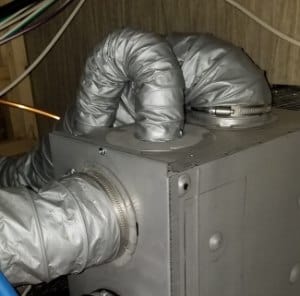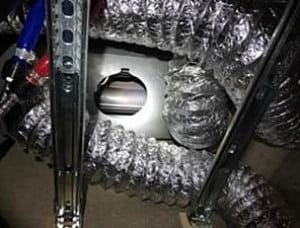Any HVAC engineer will tell you that flex duct is a necessary evil. It’s quick to install but retards airflow. Your RV may have quite a bit of 4” flex duct running from your furnace to your heating registers. And if it’s not installed properly, you could be paying for heat you’re not enjoying!
Introduction to RV Furnace Ducting
If you don’t know about ducting, the essentials aren’t difficult to grok. Basically, ducts are like roadways for air. Your furnace blower fan pumps hot air through these ducts to your registers. These registers (think traffic controllers) direct the heated air into the living space of the RV, and you feel comfortable.
Some furnaces are hard-ducted directly into a distribution plenum. Other times (see pictures below), the ducts are connected directly to the furnace case.
Your blower fan must work to move all this air, though. Generally, the smoother and straighter the ductwork, the more airflow you’ll get. The longer and curvier the ductwork, the less airflow you’ll get. Messy ductwork increases backpressure, and your blower fan can only deliver so much.

The typical forced-air RV furnace, like the Dometic DF Series, has a static pressure rating of 0.10” WC. (You can think of static pressure as the “strength” of the blower fan.) However, the typical residential furnace has a static pressure rating 0.5” WC. So you can see that the average home furnace blower is significantly “stronger” than an RV furnace!
That means how flex duct is installed is a big deal. Messy ducting can easily overwhelm the system. So how was your duct installed? Carefully or carelessly?
The Failures of Flex Ducting In RVs
Much of our knowledge about flexible ducting performance comes from residential construction. One of my favorite building science blogs is Energy Vanguard by Allison Bailes. Here’s what he writes in his post, “The Science of Sag – Flex Duct and Air flow.”
“In my opinion, flex duct is just fine as long as you don’t abuse it. Pull it tight. Use it mainly for straight runs. Occasionally, you may find a place where you can make a long, gentle turn, and that can be OK. [But] the analysis … doesn’t apply to the extra turbulence you get when you make a mess of turning the air. If you do really stupid stuff, like put a sharp kink in it … that only adds to the problems of the liner not being pulled tight.”
-Alison Bailes
Flex ducting hits you with a double whammy. Not only does it naturally sag and bend, but the corrugated walls are awful for airflow. They induce turbulence, which is the air equivalent of a five-car pileup on the freeway. The air moves around the duct rather than through the duct. When flex duct is left loose, the corrugations get worse. Pressure increases and airflow suffers.
This is a known failure mode. Hence illustrations like this in the Dometic DF Series Furnace Installation Manual:
Dometic is right. There’s nothing inherently “wrong” with flex ducting if it’s pulled tight, not crushed, and turns in gentle sweeps rather than hard 90-degree turns. Now, here’s the big question: Was your RV built this way? Or was your RV built hastily with little disregard for crushed, sagging, or kinked ducts?
Symptoms of a Bad Furnace Flex Duct
Generally, RV manufacturers will test that your furnace works. They will make sure air is coming out of your registers – but not necessarily how much. A partially crushed duct may go unnoticed at the factory, but you’ll notice it on a chilly autumn night!
You can read this story of an RV owner who found flex ductwork crushed nearly flat under his water tank. Or this story of an RV owner who found an open knockout on his furnace chamber. Unfortunately, these issues aren’t uncommon.


A common symptom of messy flex duct installation is a hot cabinet. If you notice that when you turn on your furnace, a certain cabinet gets hot, that’s an indication of a blocked, kinked, or leaky duct. (To add insult to injury, flex ducting in RVs is rarely insulated). So heat is escaping into your cabinets instead of your living space. This is not only uncomfortable (you’re cold), but also potentially damaging (cabinet is hot), because high heat can damage wood, peel vinyl wraps, or shorten the life of electrical components.
How to Inspect Furnace Ducting
You can inspect flex ducting by looking behind your cabinets. You might need to remove access panels or drawers. The flex duct should be pulled tight, run straight, and uncrushed. Obviously, there should be no holes or tears. If so, patch with HVAC foil tape or replace with new ductwork.
If you have a trunk n’ branch system with hard ducting, the main hard duct may be hidden in the underbelly or basement, but thankfully most trunk n’ branch systems don’t use flex ducts for the main trunk, just the individual branches. You can always contact your RV manufacturer and ask for an HVAC schematic (good luck!).
If you want to be your own RV technician, you can measure the airflow at each heat register with an anemometer. You can then sum all the airflows together and compare the results to the required system CFM. If it’s too low, you have a problem. This will often manifest itself as the burner cycling off-on at the high-temperature limit.
P.S. Don’t just double-check your supply registers; check your return air paths, too!
Leave a Reply